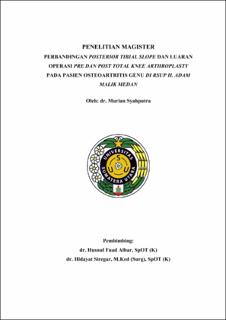| dc.description.abstract | fairly high prevalence in the world population which is a leading source of disability
for public health. Total Knee Arthroplasty (TKA) has been widely accepted as a
definitive therapy for cases of knee OA that have failed nonoperative therapy.
Posterior Tibial Slope (PTS) is a crucial factor influencing anteroposterior stability,
range of motion, tension on knee ligaments, and the balance of flexion and
extension gaps in knee arthroplasty. There is a potential role for PTS as an indicator
of knee joint recovery and TKA success in osteoarthritis patients.
Objective: Examining the PTS in post-TKA osteoarthritis patients at H. Adam
Malik Hospital, Medan.
Methods: This study used a retrospective cohort approach on OA patients who
underwent TKA surgery at H. Adam Malik General Hospital, Medan in September
2021 – October 2022. All data in this research was taken from the patient's medical
records. In subjects who met the inclusion criteria, visual analog scale (VAS), range
of motion, and PTS were examined before and after the TKA procedure. The data
obtained was analyzed statistically.
Results: There are differences in PTS and pre and post TKA surgical outcomes in
genu osteoarthritis patients at H. Adam Malik General Hospital Medan, with PTS
namely t = 6.872 > t table = 1.689 and p = 0.000 < 0.05, flexion outcome namely t = -
4.794 > t table = 1.689 and p = 0.000 < 0.05, extension, namely t count = 4.896 > t table
= 1.689 and p = 0.000 < 0.05, and VAS, namely tcount = 9.788 > t table = 1.689 and p
= 0.000 < 0.05.
Conclusion: After performing TKA in OA patients, there is an improvement in
PTS, flexion outcome, extension, and VAS. | en_US |


